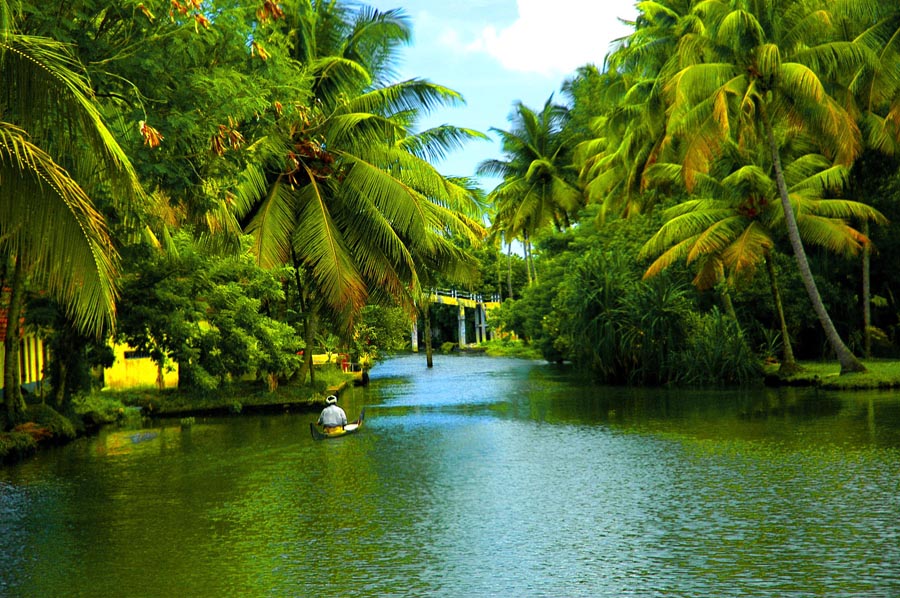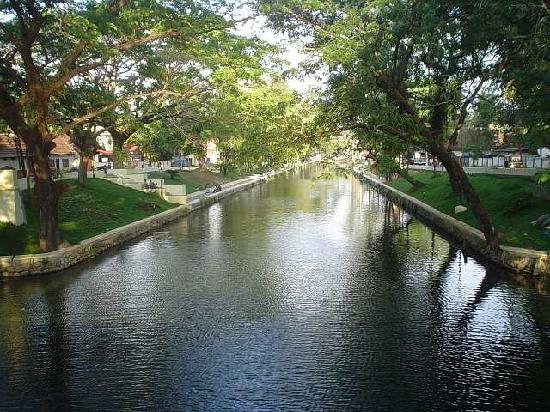 Alappuzha pronunciation (help·info)) (Malayalam: ആലപ്പുഴ) is one of the 14 districts in the state of Kerala in India. It was formed as Alleppey District on August 17, 1957. The name of the district was officially changed to Alappuzha in 1990. The district is a widely known tourist destination and is well known for its coir factories. Most of Kerala's coir industries are situated in and around Alappuzha.
Alappuzha pronunciation (help·info)) (Malayalam: ആലപ്പുഴ) is one of the 14 districts in the state of Kerala in India. It was formed as Alleppey District on August 17, 1957. The name of the district was officially changed to Alappuzha in 1990. The district is a widely known tourist destination and is well known for its coir factories. Most of Kerala's coir industries are situated in and around Alappuzha.
The district is also known for its communist traditions. It is home to the Punnapra-Vayalar uprising against the British and also the revolt against the Feudal raj. Alappuzha is strongly connected by waterways to various other parts of Kerala, including the famous tourist destination, Kumarakom.

History
The present town owes its existence to Raja Kesavadas in the second half of the 18th century but the district of Alappuzha figures in classical literature. Kuttanad, the rice bowl of Kerala, was well-known from the early periods of the Sangam age. History says Alappuzha had trade relations with ancient Greece and Rome in B.C and in the Middle Ages.
Early members of the Chera dynasty had their home in Kuttanad and were called Kuttuvans. There is archaeological evidence of the early period of the district, such as stone inscriptions and monuments, in temples and caves, as well as in literary works such as Unnuneeli Sandesam. The famous literary work of this period was ‘Ascharya Choodamani’ a Sanskrit drama written by Sakthibhadra who was a scholar of Chengannur grammar. The kingdom of Chempakasseri was at its zenith during the reign of Pooradam Thirunal Devanarayana, a great scholar and a poet who was the author of ‘Vedantha Retnamala’, a commentary on the first verse of Bhagavat Geetha. It is said that Sreekrishna Swami temple, at Ambalappuzha was constructed and the idol of Lord Krishna installed during that time. It is believed that Melpathur Narayana Bhattathiri, Neelakanta Deekshithar and Kumaran Namboothiri were eminent scholars who patronized his court.
In the 17th century the Portuguese power declined and the Dutch had a predominant position in the principalities of this district. The church located at Kokkamangalam or Kokkothamangalam was one of the seven churches founded by St.Thomas, one of the twelve disciples of Jesus Christ. The picturesque CSI Christ Church in Alappuzha town was built in 1818 by the first CMS (Church Missionary Society) missionary to India, Rev. Thomas Norton. It was the first Anglican Church to be established in the erstwhile state of Travancore.
It was at that time Maharaja Marthandavarma, the ‘Maker of modern Travancore’ interfered in the political affairs of those principalities. Marthandavarma Maharaja had a remarkable role in the internal progress of the district. The Krishnapuram Palace, which is now a protected monument of the State Archaeology Department, was constructed during that period. It was at that time that the great and talented poet Kunjan Nambiar was installed in the court. He was known as the ‘Maker of modern Alleppey’ and played a key role in making Alappuzha a premier port town of Travancore.
During the reign of Balaramavarma Maharaja, Velu Thampi Dalava took keen interest in the development of the town and port. He brought the whole area of the island Pathiramanal under coconut cultivation and large tracts under paddy cultivation. The role ofVelu Thampi Dalava in the development of Alappuzha is worth mentioning. In the 19th century the district attained progress in all spheres.
The first modern factory for the manufacture of coir mats and mattings was also established in 1859 at Alappuzha. The town Improvement Committee was set up in 1894.
This district had a prominent role in the freedom struggle of the country. The campaign for the eradication of untouchability was organized much earlier in this district by T.K. Madhavan, a fearless journalist and in 1925 the approach roads to the temples, especially in Ambalappuzha Sree Krishna Swami temple were thrown open to the Hindus of all castes. The district also witnessed the ‘Nivarthana’ movement which was started as a protest against the constitutional repression in 1932. The first political strike in Kerala was held at Alappuzha in 1938.

Tourism
The name Alappuzha is derived from 'Aal(Sea)+ puzhai(River-mouth)(The joining place of a river and the sea)' (Malayalam/Tamil ). Alappuzha is one of the most important tourist centres in the state, with a large network of inland canals earning it the sobriquet "Venice of the East". These large networks of canals provide Alleppey its lifeline. Alappuzha was one of the busiest centers of trade in the past with one of the best-known ports along the Malabar coast. Even today it retains its charm as the center for Coir carpet industries and prawn farming. Alappuzha, the ideal headquarters for backwater tourism as well as for visits to the lovely church filled town of Kottayam, and the town of Aranmula, are famous for their historic Aranmula Snake Boat Race which is an annual event. Chengannur in Alappuzha is the nearest railway station to Sabarimala. The Krishnapuram Palace is inKayamkulam. The Buddha idol, Saradamandiram are the main attraction of Mavelikkara. The Buddha statue is in a seated posture, resembling Padmasana. A feature common to the idols is that hair has not been engraved on the head. Studies by the Archaeology Department have not been able to explain the absence of hair which is common in Buddha statues of the Gandhara and Mathura tradition. The head has markings resembling a headgear. Though the department has made a pagoda-like structure for the statue, no information on the idol is available to tourists who visit the area. Local people in the area light lamps before the idol. The idol at Mavelikara is 4 feet (1.2 m) high and is perhaps, the biggest. The engravings on the head resemble a helmet of Greek statues. The mark of a sacred thread is visible on the body. Another feature is the marking of a shawl on one shoulder. Here the Archaeological Department has put up a board specifying the age of the statue. Saradamandiram was the residence of Keralapanini.
Alappuzha is also known for its snake-boat races held on the second Saturday of August, every year. This competition; the Nehru boat race takes its name from India's first prime minister Jawaharlal Nehru, which was inaugurated in 1952. It is excitement all around as snake-boats, each manned by over a hundred oarsmen, cut through the waters like wind. The event is a tremendous success with tourists and the local population alike.
The boat cruise along the backwaters of Alappuzha gives one a first hand experience of the lifestyle; toddy tapping, fishing for small fry, Coir-making, prawn farming etc., which remains more or less unchanged over the years.
The latest addition to Alappuzha is the which features countless arts and artifacts. Revi Karunakaran was the architect of a modern Coir industry that still employs more than 500,000 people in the state of Kerala. The objects featured at the Museum were collected by his family over three generations and features unique artistic pieces from all parts of the world.
Alappuzha, the district headquarters, is a town with picturesque canals, backwaters and lagoons, was described as the "Venice of the East" by Lord Curzon.
Kuttanadu
Festivals
Chettikulangara Bharani is the most important festival in Alappuzha district. The festival is one among the important temple festivals of Kerala. A Chettikulagara Bhagavathi Temple, a temple dedicated to the Goddess Bhagavathi is about four kilometers from Mavelikkara. The festival occurs on the Bharani asterism in February/March. The main rituals of the festival are the 'Kuthiyottam' and 'Kettukazcha'. The 'Kuthiyottam' features a procession of young boys who have observed rigorous ritual penance. Traditional drums, music and glittering ornamental parasols accompany this procession of boys who dance in a trance.
'Chirappu Mahotsavam' is a big occasion at Mullackal Temple in December. Christmas comes in between the festival and Alappuzha town is a really happening place at the time. The streets are full of wandering markets and entertainment ventures like circuses and exhibitions. The streets are be crowded throughout the month and there is be a 'Shiveli' or the magnificent display of nine Tuskers accompanied by the 'Chenda' and the 'Panchavadyam' music.
Padanilam Sivarathri is another important religious event in Alappuzha district. This festival is held every year in the Padanilam Parabrahma Temple. The temple is situated in the small town of Padanilam. Padanilam is situated 'about 16 km from Mavelikkara town. This place can also be called the festival Village of Alappuzha because Padanilam witnesses a large number of festivals every year including vrischika mahotsavam and irupathiyetttamonam. Padanilam is a place of religious unity.
.
A grand annual festival is celebrated at the unique Nagaraja Temple in October/November. Another festival celebrated by the temple is a one-day Thaipooyan Kavadi. The famous Chandanakudam is celebrated at the Kidangam-Parampu Temple during December every year. Kottamkulangara Temple in Alappuzha has two festive seasons in February and March, because of the two deities with separate flag masts in the same compound wall.
The famous Kandamangalam Rajarajeshwari Temple is located in Kadakkarappally, Cherthala 1 km west of Thankey junction on NH 47. The annual festival comes in March–April. Chikkara, offering of children to the mother goddess during the festival, is the major attraction. The Chamanju Valathu of children starts on the 2nd day of the festival and lasts till the 8th day. Procession named Thalappoli start on the flag-hoisting day itself. The holy bath (Aarattu) of the goddess is held in a pool within the temple compound on the 10th day of festival.Elephant processions, fireworks, stage shows, etc. are major events that attract thousands of devotees and others.
The churches here celebrate grand annual feasts. The 'Arthunkal Perunnal' feast is celebrated at the Arthunkal Church. The famous regatta forms part of many festivals here in many places. The annual Vallam Kali (Nehru Trophy Boat Race) is held in the backwaters in the month of September associated with the Onam festival. The main attraction is theChundan Vallam (Snake Boat) race, in which a number of contestants are in the running for the famous Prime Minister's trophy, a trophy donated by Jawaharlal Nehru, the firstPrime Minister of India. Another important celebration in Alappuzha is the "Beach Festival", held from December 30 to January 2. The annual festival conducted in Champakulam "Valiya Palli" is another big festival.
Alappuzha is an important tourist destination in India. The Backwaters of Alappuzha are the most popular tourist attraction in Kerala. A houseboat cruise in these backwaters is a delightful experience. It connects Kumarakom and Cochin to the North andQuilon to the South. Alappuzha is also the access point for the annual Nehru Trophy Boat Race, held on the Punnamada Lake, near Alappuzha, on the second Saturday of August every year. This is the most competitive and popular of the boat races in India. The mullackal chirap is also one of the attractions of Allapuzha which is the festive season held ten colourful days every year in the month of December.

No comments:
Post a Comment